wanttaja
En-Route
Lancair IV pilots in the accident reports are quite a bit more experienced than the run-of-the-mill homebuilt accident. In my 1998-2007 accident database, the median total time for Lancair IV pilots was 2,380 hours, vs. 950 overall. A median of 100 hours time-in-type vs. 58 for the overall homebuilts. If you look solely at stick-and-rudder errors (Pilot Miscontrol), the Lancair IV has a lower rate than the Vans RV-6A.As it goes. Airplanes are really not that difficult of beasts to fly (at least, none of the ones that I've flown, which includes a couple of Lancairs). But people who continue to bite off more than they can chew and end up in NTSB reports.

The Lancair IV also sees a lower rate of judgment-error accidents, such as buzzing or continued VFR into IMC. This is probably due to the more-experienced pilot base.
Ron Wanttaja


